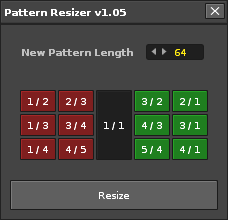Pattern Resizer
Brief description:
- This tool allows you to resize (expand or shrink) a pattern to any arbitrary length ranging from 1 to 512 lines.
Usage: - Context menu: Pattern Editor > Pattern > Resize
- Key binding : Preferences > Keys > Pattern Editor > Pattern > Resize
Notes: - Note delays will be calculated and adjusted automatically. Effect commands and automations will also be repositioned to match as closely as possible, but the effect values themselves are not recalculated or interpolated in any way, so if you use any time-based effects then you may need to be readjust these after you resize the pattern. It’s also possible that a note may be delayed/shifted to a new line, causing certain effect commands (sample reverse, sample offset, pitch, etc) to be positioned on the wrong line, so you may need to do some readjustment there as well.
- I’ve improved the GUI a little bit and have added a few handy buttons. The ‘1/1’ button will reset the length value so that it matches the current pattern. The other buttons just let you quickly jump to some (hopefully) useful fractions/variations of the pattern length. I’m open to suggestions here for what might be more useful in the long run.
- In certain situations - especially when shrinking or when your pattern already contains a lot of existing note delays - you may experience some notes being dropped. This is sort of unavoidable due to the nature of the process, as there will inevitably be certain notes that get shifted around, delayed a bit more, etc., and would then try to occupy the exact same pattern line. I have implemented a very basic system to help prioritise which notes are more ‘important’, which mainly comes into play when shrinking the pattern. I have a few ideas for how to handle this better in the future, but it’s still quite basic at the moment. Please let me know if you experience any quirky behaviour, and I’ll try to tweak it.
- Still very much a work in progress! Use at your own risk, etc. Make sure your song is backed up before you go experimenting with this thing

Changelog: - 2010-12-11 - v1.00 - Release.
- 2010-12-12 - v1.01 - Small improvements to automation and pattern command processing.
- 2010-12-19 - v1.02 - Fixed this bug. Made some small performance tweaks when processing note and effect columns.
- 2010-12-20 - v1.03 - Fixed this bug.
- 2011-03-14 - v1.04 - Updated for Renoise 2.7
- 2012-03-05 - v1.05 - Updated for Renoise 2.8
- 2015-02-24 - v1.06 - Fixed this bug.
Credits: - This tool was inspired by Syflom’s post (and possibly others I’ve read in the past).
- Some of my early code was partly based on the work of Beatslaughter.
org.illformed.PatternResizer300.xrnx (3.6 KB)
